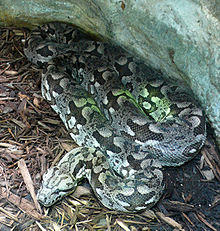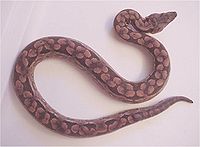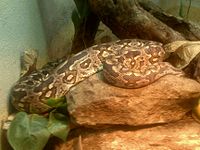- Boa dumerili
-
Boa dumerili 
Conservation status Scientific classification Kingdom: Animalia Phylum: Chordata Subphylum: Vertebrata Class: Reptilia Order: Squamata Suborder: Serpentes Family: Boidae Subfamily: Boinae Genus: Boa Species: B. dumerili Binomial name Boa dumerili
(Jan In Jan & Sordelli, 1860)Synonyms - Acrantophis dumerili - Jan In Jan & Sordelli, 1860
- Acrantophis dumerilii - Jan, 1863
- Boa dumerilii - Boulenger, 1893
- Acrantophis madagascariensis dumerili - Stull, 1935
- Acrantophis dumerili - Guibé, 1949
- Boa dumerili - Kluge, 1991[1]
- Common names: Dumeril's boa.[2]
Boa dumerili is a non-venomous boa species found on Madagascar and Reunion Island. No subspecies are currently recognized.[3]
Contents
Description
Adults usually grow to 6.5 feet (2 m) in length[4] with the maximum reported to be 8 foot, 6 inches (259 cm). Males usually have longer flatter tails, while females tend to be larger overall.
The color pattern consists of a gray-brown ground color with darker patches, forming an effective camouflage against the leaf litter of the forest floor of their native habitat.
Geographic range
Found on Madagascar and Reunion Island (Mascarenes). The type locality given is "Amérique mérid. ?" Given as "?" by Jan (1863).[1]
Habitat
Along the western coast and southwestern regions of Madagascar, it is found in a semi-arid habitat that gets fairly low amounts of precipitation.
Conservation status
This species is classified as vulnerable (VU) on the IUCN Red List for the following criteria: A1cd (v2.3, 1994).[5] This means that a population reduction of at least 20% has been observed, estimated, inferred or suspected over the last 10 years or three generations, whichever is the longer, based on a decline in area of occupancy, extent of occurrence and/or quality of habitat, and based on actual or potential levels of exploitation. Year assessed: 1996.[6]
Also listed as CITES Appendix I, which means that it is threatened with extinction and CITES prohibits international trade except when the purpose of the import is not commercial, for example for scientific research.[7]
Threatened by deforestation and human persecution. In some areas it is feared and often killed on sight.
Feeding
Their diet consists of small animals, such as birds, lizards, and small mammals. They are also known to prey on other snakes.
Reproduction
Sexual maturity is within 3 to 5 years of age. Males have anal spurs, which are used in courtship. Their mating season is March through May and the young are born some 6 to 8 months later. Ovoviviparous, females give birth to a litters of 6-28. Neonates are 12-18 inches (30-46 cm) long.
Captivity
Once exported from Madagascar in great numbers, trade in this species has since been heavily restricted. They are, however, quite prolific in captivity, and captive bred animals are relatively inexpensive and easy to find in the exotic pet trade. Though their size makes them more suited to someone experienced with large constrictors, they have a typically docile nature, and readily feed on rats. The main concern is that they are prone to stress, which can sometimes cause them to stop eating or contribute to other health issues.
See also
- List of boine species and subspecies
- Boinae by common name
- Boinae by taxonomic synonyms
References
- ^ a b McDiarmid RW, Campbell JA, Touré T. 1999. Snake Species of the World: A Taxonomic and Geographic Reference, vol. 1. Herpetologists' League. 511 pp. ISBN 1-893777-00-6 (series). ISBN 1-893777-01-4 (volume).
- ^ Mehrtens JM. 1987. Living Snakes of the World in Color. New York: Sterling Publishers. 480 pp. ISBN 0-8069-6460-X.
- ^ "Boa dumerili". Integrated Taxonomic Information System. http://www.itis.gov/servlet/SingleRpt/SingleRpt?search_topic=TSN&search_value=634787. Retrieved 10 July 2008.
- ^ Burnie D, Wilson DE. 2001. Animal. Dorling Kindersley. 624 pp. ISBN 0-7894-7764-5.
- ^ Acrantophis dumerili at the IUCN Red List. Accessed 10 July 2008.
- ^ 1994 Categories & Criteria (version 2.3) at the IUCN Red List. Accessed 10 July 2008.
- ^ Acrantophis dumerili at CITES and United Nations Environment Programme / World Conservation Monitoring Centre. Accessed 10 July 2008.
Further reading
- Kluge AG. 1991. Boine Snake Phylogeny and Research Cycles. Misc. Pub. Museum of Zoology, Univ. of Michigan No. 178. 58 pp. PDF at University of Michigan Library. Accessed 11 July 2008.
- Vences M, Glaw F, Kosuch J, Böhme W, Veith M. 2001. Phylogeny of South American and Malagasy Boine Snakes: Molecular Evidence for the Validity of Sanzinia and Acrantophis and Biogeographic Implications. Copeia No 4. p. 1151-1154. PDF at Miguel Vences. Accessed 29 August 2008.
- Vences M, Glaw F. 2003. Phylogeography, systematics and conservation status of boid snakes from Madagascar (Sanzinia and Acrantophis). Salamandra, Reinbach, 39(3/4): p. 181-206. PDF at Miguel Vences. Accessed 29 August 2008.
External links
- Acrantophis dumerili at the Reptarium.cz Reptile Database. Accessed 10 July 2008.
Categories:- IUCN Red List vulnerable species
- Boinae
Wikimedia Foundation. 2010.



